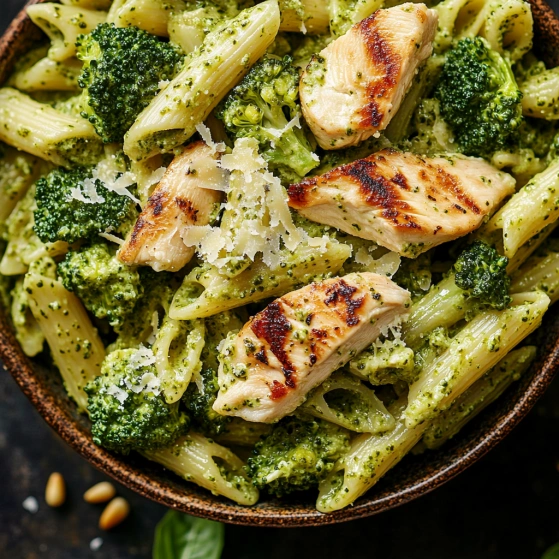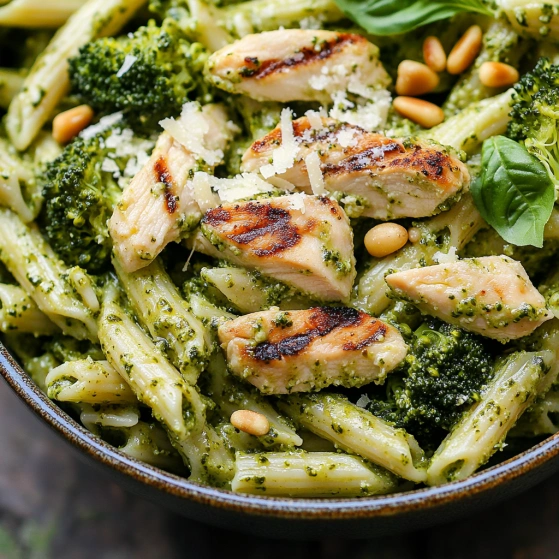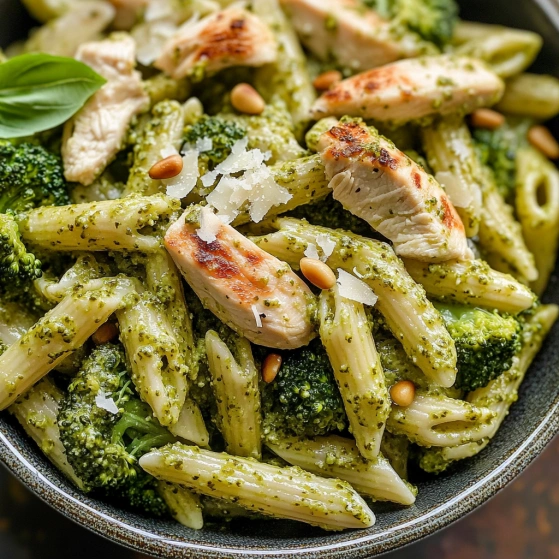 Pin it
Pin it
This broccoli chicken pesto pasta combines fresh homemade pesto with tender chicken and nutritious broccoli for a complete meal that comes together quickly. The vibrant green sauce coats every bite with herbal freshness while the protein and vegetables make it satisfying enough for any weeknight dinner.
I first made this recipe when my herb garden was overflowing with basil and now it's requested at least twice a month in our home. The aroma of fresh basil and garlic filling the kitchen always brings my family to the table before I even call for dinner.
Ingredients
- Fresh basil leaves: Provide the signature flavor and vibrant green color. Look for bright leaves without any browning
- Parmesan cheese: Adds nutty saltiness. Always grate it fresh for the best flavor
- Pine nuts: Contribute richness. Toasting them first enhances their flavor dramatically
- Garlic cloves: Give that essential pungent kick. Choose firm bulbs without any sprouting
- Extra virgin olive oil: Creates the silky texture. Use a good quality oil since it's a key flavor
- Lemon juice: Helps maintain the bright green color and adds brightness
- Salt and pepper: For seasoning
- Pasta of choice: Works with any shape that holds sauce well. Choose bronze die cut pasta for better sauce adherence
- Boneless skinless chicken breasts: Provide lean protein. Look for organic if possible
- Broccoli florets: Add nutrition and texture. Choose bright green tight heads
- Olive oil: For cooking the chicken. Regular olive oil works fine here
- Seasonings: Enhance the chicken flavor
- Reserved pasta water: Contains starch that helps the sauce cling to the pasta
Step-by-Step Instructions
- Prepare the Pesto:
- Process the base ingredients by combining basil, Parmesan, toasted pine nuts, and garlic in a food processor. Pulse until everything is finely chopped but not pureed. The texture should still have some small pieces visible for the best mouthfeel.
- Add the oil gradually:
- While the processor runs, create an emulsion. This slow addition is crucial for creating the perfect silky texture rather than an oily herb mixture. Season with salt, pepper, and a squeeze of lemon juice to preserve the vibrant green color.
- Cook the Pasta:
- Boil properly salted water in a large pot. The water should taste like the sea for proper pasta flavor. Cook the pasta until al dente, following package directions but checking 1 minute early. Before draining, reserve some starchy pasta water which will help bind the sauce to the pasta.
- Prepare the Chicken:
- Season and cook the chicken pieces thoroughly. Dust with salt, pepper, garlic powder, and onion powder before adding to a hot skillet with olive oil. Cook until golden brown on the outside and no longer pink inside, approximately 5 to 7 minutes depending on the size of your pieces. The chicken should reach 165°F internal temperature.
- Combine and Finish:
- Assemble everything in one pan by adding the drained pasta to the cooked chicken. Pour the freshly made pesto over everything while still warm. Toss gently to coat every piece with the vibrant sauce. Add small amounts of reserved pasta water as needed until the sauce reaches a silky consistency that coats the pasta perfectly.
 Pin it
Pin it
The pine nuts are my favorite component of homemade pesto. I once tried substituting walnuts when I ran out of pine nuts, and while it was good, the subtle buttery flavor of properly toasted pine nuts makes all the difference in creating an authentic pesto that transforms this simple pasta dish into something special.
Storage and Meal Prep
This pasta dish keeps beautifully in the refrigerator for up to three days in an airtight container. The flavors actually develop and meld together overnight, making it possibly even better the second day. If you plan to make it ahead, consider slightly undercooking the pasta and broccoli as they will continue to soften when reheated. For meal prep purposes, you can store the components separately and assemble just before serving.
Ingredient Substitutions
The beauty of this recipe lies in its flexibility. No pine nuts? Walnuts, almonds, or even pepitas work wonderfully in the pesto. For a dairy-free version, nutritional yeast can replace the Parmesan. The protein can be swapped for shrimp, white beans, or tofu for vegetarian options. If fresh basil isn't available, you can use store-bought pesto and enhance it with fresh herbs like parsley or baby spinach for more green power.
Serving Suggestions
Serve this pasta as a complete meal on its own or with a simple side salad dressed in lemon vinaigrette to complement the herb flavors. A glass of crisp white wine like Pinot Grigio or Sauvignon Blanc pairs beautifully with the herbal notes of the pesto. For a special touch, place a small bowl of red pepper flakes and extra grated Parmesan at the table so everyone can customize their bowl to taste.
 Pin it
Pin it
Frequently Asked Questions
- → Can I make the pesto ahead of time?
Yes! Homemade pesto can be made up to 3 days ahead and stored in an airtight container in the refrigerator. Add a thin layer of olive oil on top to prevent discoloration. You can also freeze pesto in ice cube trays for up to 3 months.
- → What can I substitute for pine nuts in the pesto?
If pine nuts are unavailable or too expensive, you can substitute walnuts, almonds, or even sunflower seeds. Each will provide a slightly different flavor profile but will work well in the pesto.
- → Can I use frozen broccoli instead of fresh?
Yes, frozen broccoli works fine in this dish. Simply thaw it first and reduce the cooking time slightly since frozen broccoli is typically blanched before freezing. You may want to pat it dry to prevent excess water in your final dish.
- → How can I make this dish vegetarian?
To make this dish vegetarian, simply omit the chicken and add more vegetables such as cherry tomatoes, bell peppers, or zucchini. You could also substitute the chicken with chickpeas or white beans for added protein.
- → What's the best pasta shape to use for this dish?
Shapes that trap sauce work best, such as fusilli, penne, or farfalle. These pasta shapes have nooks and crannies that hold the pesto sauce well. However, long pasta like spaghetti or linguine can also work beautifully.
- → Why is pasta water added to the sauce?
The starchy pasta water helps the sauce cling to the pasta better and creates a silkier texture. It also helps thin out the pesto to the perfect consistency without diluting the flavor like plain water would.
